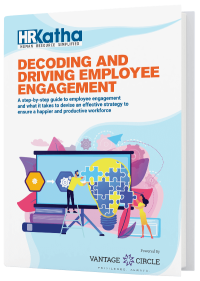Maslow's Hierarchy of Needs in Employee Engagement (Pre and Post Covid 19)

We all are familiar with "Maslow's hierarchy of needs" theory. The theory brings our attention to the fundamental needs of humans in a five-tier pyramid model.
Abraham Maslow proposed his theory "Maslow's hierarchy of needs" in his 1943 paper "A Theory of Human Motivation" in Psychological Review.
Maslow classifies the needs that humans need as follows.
-
Physiological needs
-
Safety needs
-
Love and belonging needs
-
Esteem needs
-
Self-actualization
The sequence in which these needs are classified has its significance and is not coincidental.
According to Maslow, humans must meet their physiological needs first before they meet their safety needs. And when these two needs are met, humans intrinsically move to seek love and belonging needs and so on.
To live a healthy and meaningful life, humans seek higher goals and desires. Or try to meet the needs at the individual levels to complete the hierarchy.
A brief look at the Hierarchical Levels
Physiological needs- these needs are the biological need that is essential for survival; for example, food, air, water, shelter, clothing, warmth, sex, and sleep.
These are the basic needs and the most important for any human function optimally. One cannot survive and cannot move to the next level unless these needs are met.
Safety needs- Once the physiological needs are met, safety needs become more critical. At this level, people look for safety and security to protect themselves, experience predictability, and control their lives.
These needs are met by family and society at large, for example, by having emotional security, financial security, social stability, law and order, health, and wellbeing.
Love and belonging needs- After the physiological and security need, people long for deeper human bonding and love from the surrounding. The need for interpersonal relationships triggers in this stage.
Friendships, intimacy, trust, acceptance, receiving and giving affection, and love are examples.
Esteem needs- The fourth level of Maslow's hierarchy of needs emphasizes esteem needs. It can be classified into two categories-
-
Esteem for oneself- it roots from independence, mastery, dignity, or any personal achievement.
-
Esteem from others- you also boost your esteem when you are acknowledged and respected by others.
Self-actualization needs- Maslow describes this level as to desire to accomplish everything that one puts their mind into; to become the best possible self. It is to become aware of one's true potential and consciously use it for self-fulfillment, personal growth, and peak experiences.
The perception of this level varies from person to person. One might fulfill it by becoming a world-class athlete. Others might find it in expressing creativity through diverse art forms.
Maslow's Hierarchy And Employee Engagement
As you can understand from Maslow's theory, all the five needs are critical and intended to track human growth and development. We can apply the same theory to understand how employees are engaged and why it is essential to maintain the hierarchy levels.
Maslow's theory is relevant from an employee engagement perspective. It is interesting to bring this psychoanalytic observation to employee engagement.
On the first level, Maslow tells how vital physiological needs are. And how basic needs like food, water, and shelter are essential for survival and optimal human functioning. For the employees, the basic needs in a job are the salary that helps them be financially independent and live a life they are accustomed to. These needs are also drivers for their health and wellbeing. Employees must fulfill this need first to move to the next level.
Next comes job stability, security, and a stable work environment. The employees would not be satisfied with their jobs if they do not fulfill these security needs. Employees want to feel safe and secure as far as job security is concerned and not get affected by the uncertainty of the job market.
When the first two crucial employee needs are met, employees look for belongingness. These needs are fulfilled by healthy work culture, coperative colleagues, and supportive bosses.
In the 4th stage, employees want acknowledgment for the effort they put into their work. Recognition from their co-workers and feeling of accomplishment is vital for them to stay engaged and satisfied and fulfill their esteem needs.
The last level brings self-actualization, where employees want to develop their skills and become experts in their respective fields. This level boosts their potential that helps them to lead and motivate others.
Maslow's Hierarchy of Needs in Pre and Post Covid 19 State
Maslow argues that when people fail to meet the needs at the various stages of the hierarchy, they suffer from mental health issues. And it takes a toll on their overall wellbeing.
Similarly, when employees' hierarchical needs are not met, they show a low level of employee engagement. And it impacts employee morale, productivity, and retention severely.
But is this theory still relevant and applicable in 2020 when the global workforce is going through a crisis due to the COVID19 pandemic? Employees are adjusting their seats to adapt to remote work culture. The intriguing fact is that world leaders and managers always emphasize these needs of their employees and bring opportunities that can help them stay satisfied and engaged.
But can they do the same today? When the global workforce is uncertain about the future. Here is an analogy.

Physiological and Safety needs
Before Covid-19: These needs were taken for granted. Employers provided them.
After Covid-19: Anxiety and stress over job security, worry about the future, uncontrolled, and unorganized work environment.
Solution: Constant monitoring and get a sentiment of the company through tools like Vantage Pulse.
Nudge people to a healthy lifestyle with digital mental wellness solutions, employee assistance programs, and corporate health apps like Vantage Fit and Headstart.
Belonging needs
Before Covid-19: It was taken care of by the colleagues, HR, and seniors, creating a feeling of camaraderie.
After Covid-19: With employees going remote, the flow of communication is compromised more or less. Employees can no longer bond over impromptu in-person meetings or discuss work over a cup of coffee.
Solution: Conducting virtual meetings with the employees and communicating regularly with communication tools like Zoom, MS Teams, Slack, Skype, Gtalk, and much more.
Listen to our podcast on: How to engage employees during Covid times with Amit Sharma.
Esteem needs
Before Covid-19: Bosses and colleagues used to appreciate and recognize in regular group meetings and town halls.
After Covid-19: Esteem needs have been compromised severely. Managers and peers could no longer keep the feedback loop going and recognize their remote employees in time.
Solution: The need of the hour to tackle this issue is to implement digital Rewards and Recognition platforms like Vantage Rewards. The digital recognition platform boosts their morale and keeps the culture of feedback intact for remote working employees.
Self-actualization needs
Before Covid-19: Self- actualization needs were generally managed by self but in a conducive work environment.
After Covid-19: The limited infrastructure and communication channels affected the pace of self-actualization. Motivation is compromised.
Solution: Employers can enhance the flow of self-actualization by providing online learning tools for remote workers. Robust communication tools to connect team members are also crucial for addressing this need.

Vantage Circle is a simple AI-powered Rewards & Recognition Platform for upgrading your employee experience and engagement for better productivity.






